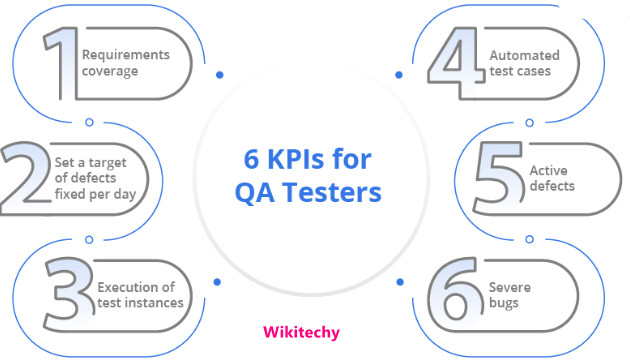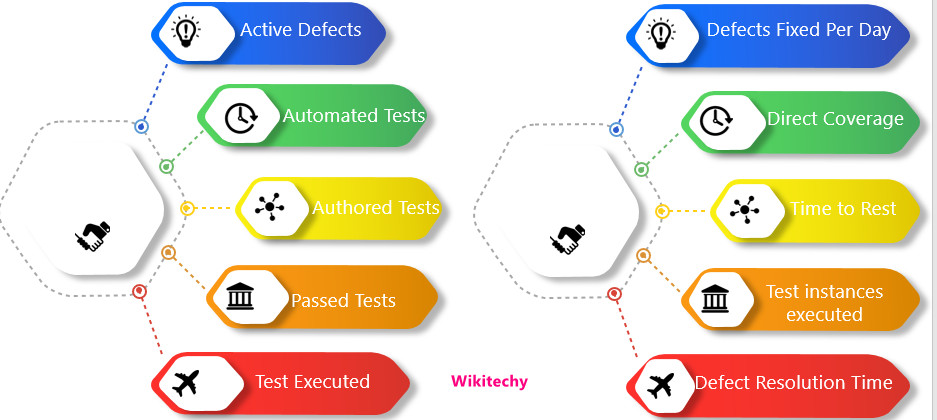What are the KPIs of Software Testing - Selenium Testing Tutorial
Software Testing Key Performance Indicators(KPIs)

- KPI is a type of performance measurement indicators which are used by the organizations and testers to get the data that can be measured.
- To ensure the compliance of process with the objectives of business, KPIs are measured and analyzed by the testing team.
- Moreover, they help the team take any necessary steps, in case the performance of the product does not meet the defined objectives.
- For achieving the target effectively,that was defined during planning, strategic and or budget sessions, are the important metrics which is calculated by the software testing team to check if the project is moving in the right direction.
The various important KPIs for software testers are

Active Defects
- Simple and a very important KPI,these active defects help to identify the status of a defect-new, open, or fixed and allows them to take necessary steps to rectify it.
- Active kpis are measured based on the treshold set by the team and are marked for immediate action if they are above the threshold.
Automated Tests
- It is important for the test manager to identify the automated tests, while monitoring and analyzing the key performance indicators.
- These tests allow the team to track the number of automated tests, which helps to catch and track the critical and high priority defects in the software delivery system.
Covered Requirements
- We can track the percentage of requirememnt covered by atleast one test by using the key performance indicator.
- To ensure 100% test and requirements coverage the test manager uses these KPIs everyday.
Authored Tests
- This is a very important key performance indicator which is used by the test manager to analyze the test design activity of their business analysts and test engineers.
Passed Tests
- Team monitors the execution of every last configuration within a test and the percentage of tests passed is evaluated and measured.
- This helps the team in understanding how effective the test configurations are in detecting and trapping the defects during the process of testing.
Test Instances Executed
- This is a key performance indicator which is related to the velocity of the test plan execution and is used by the testing team to highlight the percentage of the total instances available in a test set.
- However, this KPI does not offer an insight into the quality of the build.
Test Executed
- After the test instances have been determined the team moves ahead and monitors the different types of test execution such as manual and automation.
- This is also a velocity KPI like test instances executed.
Defects Fixed Per Day
- By using this KPI, the test manager can monitor the number of defects fixed on daily basis and the efforts invested by the team to track these defects and issues.
- Test manager can also use these KPI to see the progress of the project and the testing activities.
Direct Coverage
- Manual and automated coverage feature can be performed using this feature.
- This ensures that all the features and functions are completely and throughly tested.
- In a particular sprint if any of the component is not tested, it will considered as incomplete and will not be moved until it is tested.
Percentage of Critical & Escaped Defects
- This is an important kpi which needs the attention of software testers.
- The team kpi ensures that testing effort are focussed on rectifying critical issues and defects in their product.
- This KPI also ensures the quality of the entire testing process as well as the product.
Time to Test
- KPI focuses to help the software testing team to measure the time taken move from stage of testing to “done” status.
- It also helps in calculating the effectiveness as well as efficiency of the testers and understanding the complexity of the feature of the application under test.
Defect Resolution Time
- The time taken by the testing team to measure bugs in the software, defect resolution time and to verify and validate the fix.
- To measure and qualify the tester responsibility and owner ship of the bugs and to keep track of the resolution time DRT is used.
- So, defect resolution time helps to track the bugs and make sure bugs are fixed the way they are supposed to be fixed, to close the issue at a reasonable time, this KPI can be used.
Successful Sprint Count Ratio
- Though successful sprint Count Ratio is a software testing metric, this is used by testers as KPI when all the successful sprint statistics are collected.
- This helps testers to calculate the percentage of successful sprints using the formula:
Successful Sprint Count Ratio: (Successful Sprint / Total Number of Sprints) x 100.
Quality Ratio
- Based on the passed or failed rates of the test executed, the quality ratio is used as software testing metrics and
The formula used for this is
Quality Ratio: (Successful Tests Cases / Total Number of Test Cases) x 100.
Test Case Quality
- KPI and a software testing metric, test case quality helps to evalute and score the written test cases based on certain defined criteria.
- This helps to ensure that all the test cases are examined either by producing quality test scenarios or with the assistance of sampling.
- To ensure the quality of the test cases, team needs to consider certain factors such as
- For finding faults and defects test case should be written.
- Test & requirements coverage should be fully established.
- The areas that are affected by the defects should be identified and mentioned clearly.
- All possible solutions should be covered and test data should be provided accurately.
- It should also cover success and failure scenarios.
- Expected results should be written in a correct and clear format.
Defect Resolution Success Ratio
- By calculating this KPI, the team of software testers can find out the number of defects resolved and reopened.
- If none of the defects are reopened then 100% success is achieved in terms of resolution. Defect resolution success ratio is evaluated with the assistance of the following formula:
Defect Resolution Success Ratio = [ (Total Number of Resolved Defects) – (Total Number of Reopened Defects) / (Total Number of Resolved Defects) ] x 100.
Process Adherence & Improvement
- This KPI can be used for the software testing team to reward them and their efforts if they come up with any ideas or solutions that simplify the process of testing and make it agile as well as more accurate.
